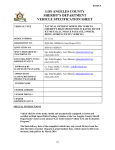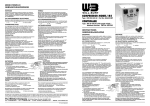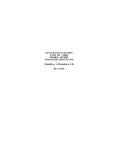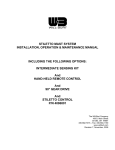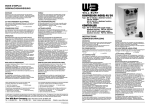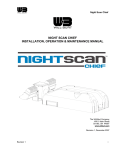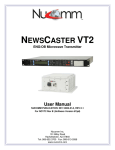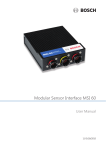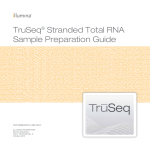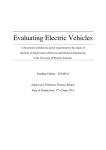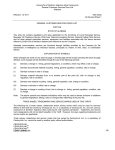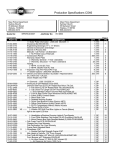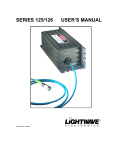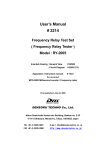Download to user manual.
Transcript
INSTALLATION, OPERATION, AND MAINTENANCE MANUAL
COMBINED SYSTEM OF:
D-Tec II SENSOR
&
D-Tec II DISPLAY
The Will-Burt Company
169 S. Main Street
Orrville, OH 44667
330-682-7015 – Fax: 330-684-1190
www.willburt.com
Revision 5, April 2007
WARRANTY
The Manufacturer warrants its products to be free from defects in material and workmanship
for a period of one year from the date of shipment from the factory. The Manufacturer shall
not be responsible for any damage resulting to or caused by its products by reason of
improper installation, improper storage, unauthorized service, alteration of products, neglect
or abuse, or use of the product in a manner inconsistent with its design, accident, acts of God,
or failure to properly maintain this product. This warranty does not extend to any component
parts not manufactured by Manufacturer, however, Manufacturer's warranty herein shall not
limit any warranties made by manufacturers of component parts which may extend to Buyer.
THE FOREGOING WARRANTY IS IN LIEU OF ALL OTHER WARRANTIES, AND NO
REPRESENTATIONS, GUARANTEES OR WARRANTIES, EXPRESS OR IMPLIED,
(INCLUDING, BUT NOT LIMITED, TO A WARRANTY OF MERCHANTABILITY OR
FITNESS FOR A PARTICULAR PURPOSE) ARE MADE BY MANUFACTURER IN
CONNECTION WITH THE MANUFACTURE OR SALE OF ITS PRODUCTS. NO
EMPLOYEE, DISTRIBUTOR, OR REPRESENTATIVE IS AUTHORIZED TO CHANGE
THIS WARRANTY IN ANY WAY OR GRANT ANY OTHER WARRANTY ON
BEHALF OF MANUFACTURER.
Claims for defects in material and workmanship shall be made in writing to Manufacturer
within thirty (30) days of the discovery of defect. Failure to provide notice as required hereby
shall be conclusive evidence that the product was in conformity with the warranty, and the
Manufacturer shall be released from any and all liability relating to the product. Manufacturer
may either send a service representative or have the product returned to its factory at Buyer's
expense for inspection. If judged by Manufacturer to be defective in material or
workmanship, the product will be replaced or repaired at the option of Manufacturer, free
from all charges except authorized transportation.
THE REMEDIES OF BUYER SET FORTH HEREIN ARE EXCLUSIVE AND ARE IN
LIEU OF ALL OTHER REMEDIES.
THE LIABILITY OF MANUFACTURER
WHETHER IN CONTRACT, TORT, UNDER ANY WARRANTY, OR OTHERWISE,
SHALL NOT EXTEND BEYOND ITS OBLIGATION TO REPAIR OR REPLACE, AT ITS
OPTION, ANY PRODUCT OR PART FOUND BY MANUFACTURER TO BE
DEFECTIVE IN MATERIAL OR WORKMANSHIP. MANUFACTURER SHALL NOT
BE LIABLE FOR COST OF INSTALLATION AND/OR REMOVAL, OR BE
RESPONSIBLE FOR DIRECT, INDIRECT, SPECIAL OR CONSEQUENTIAL
DAMAGES OF ANY NATURE.
D-Tec II
TABLE OF CONTENTS
1. INTRODUCTION
1-1
1.1 Safety Precautions .................................................................................................................................................1-1
1.2 Introduction............................................................................................................................................................1-1
1.3 Description.............................................................................................................................................................1-1
1.4 Reference Data.......................................................................................................................................................1-2
2. INSTALLATION
2-1
2.1 Introduction............................................................................................................................................................2-1
2.2 Tools and Materials required for Installation.........................................................................................................2-1
2.3 Unpacking..............................................................................................................................................................2-2
2.4 Installation .............................................................................................................................................................2-2
2.5 Pre-operational Check..........................................................................................................................................2-11
3. OPERATING INSTRUCTIONS
3-1
3.1 Theory of Operation...............................................................................................................................................3-2
3.2 Power-Up Sequence...............................................................................................................................................3-2
3.3 Raising the Mast ....................................................................................................................................................3-2
3.4 Clearing an Alarm..................................................................................................................................................3-3
3.5 Overriding an Alarm..............................................................................................................................................3-3
4. MAINTENANCE AND SERVICE INSTRUCTIONS
4-1
4.1 Introduction............................................................................................................................................................4-1
4.2 Tools Required.......................................................................................................................................................4-1
4.3 Scheduled Maintenance .........................................................................................................................................4-1
4.4 Troubleshooting.....................................................................................................................................................4-2
5. PARTS LIST
5-1
5.1 Introduction............................................................................................................................................................5-1
6. REFERENCE INFORMATION
6-1
6.1 General...................................................................................................................................................................6-1
6.2 List of Abbreviations .............................................................................................................................................6-5
7. REVISIONS
7-1
8. SOFTWARE REVISIONS
8-1
Revision 5
i
D-Tec II
LIST OF ILLUSTRATIONS
Figure 1-1 D-Tec II.......................................................................................................................................................... 1-2
Figure 2-1 D-Tec II Sensor in Upright Position............................................................................................................... 2-2
Figure 2-2 D-Tec II Installation with Dish Antenna ........................................................................................................ 2-3
Figure 2-3 D-Tec II Installation with Multi-Element Antenna ........................................................................................ 2-4
Figure 2-4 Mounting Dimensions for Rack Mounted Display......................................................................................... 2-4
Figure 2-5 Drill Pattern for Panel Mounted Display........................................................................................................ 2-5
Figure 2-6 Display Unit Connector Information.............................................................................................................. 2-6
Figure 2-7 Wiring of J6.................................................................................................................................................... 2-7
Figure 2-8 Wiring of J3.................................................................................................................................................... 2-8
Figure 2-9 Wiring of J4.................................................................................................................................................... 2-9
Figure 2-10 Wiring of J5.................................................................................................................................................. 2-9
Figure 2-11 Complete System Schematic ...................................................................................................................... 2-10
Figure 4-1 Tilt Axes......................................................................................................................................................... 4-7
Figure 5-1 D-Tec II Sensor (912672)............................................................................................................................... 5-3
Figure 5-2 D-Tec II Display (913949) ............................................................................................................................. 5-3
Figure 5-3 D-Tec II Rack Mounting Display (915063) ................................................................................................... 5-4
Figure 5-4 Exterior Mounting Bracket, MRC Ellipse 2000............................................................................................. 5-4
Figure 5-5 Exterior Mounting Bracket, MRC Prostar...................................................................................................... 5-5
Figure 5-6 Air Control Valve........................................................................................................................................... 5-5
Figure 6-1 Typical Electric Fields ................................................................................................................................... 6-1
Figure 6-2 Typical Magnetic Fields................................................................................................................................. 6-1
Figure 6-3 Electric Field Pattern...................................................................................................................................... 6-2
Figure 6-4 Electric Field Patterns .................................................................................................................................... 6-3
Figure 6-5 H-Field Pattern ............................................................................................................................................... 6-3
Figure 6-6 Ultrasonic Detection....................................................................................................................................... 6-4
LIST OF TABLES
Table 1-1
Table 1-2
Table 2-1
Table 4-1
Table 4-2
Table 5-1
Table 5-2
Table 6-1
Revision 5
Reference Data ................................................................................................................................................ 1-2
General Dimensions ........................................................................................................................................ 1-2
Tools and Materials Required for Installation ................................................................................................. 2-1
Tools Required for Maintenance ..................................................................................................................... 4-1
State Indications .............................................................................................................................................. 4-2
Replacement Parts ........................................................................................................................................... 5-1
D-Tec II Installation Kit .................................................................................................................................. 5-2
List of Abbreviations ....................................................................................................................................... 6-5
ii
D-Tec II
SAFETY SUMMARY
SIGNAL WORD DEFINITION
Per the ANSI Z535.4 standard, the following signal words and definitions are used to indicate hazardous situations:
DANGER indicates an imminently hazardous situation that, if not avoided, will result in death or serious injury.
WARNING indicates a potentially hazardous situation that, if not avoided, could result in death or serious injury.
CAUTION indicates a potentially hazardous situation that, if not avoided, may result in minor or moderate injury. It is
also used to alert against unsafe practices.
The following are general safety precautions that are not related to any specific procedures and therefore do not appear
elsewhere in this publication. These are recommended precautions that personnel must understand and apply during
many phases of operation and maintenance.
Electrocution Hazard! Contact with high voltage will result in death or serious injury. Observe general safety
precautions for handling equipment using high voltage. Do not locate or operate mast near electrical lines, cables or
other unwanted sources of electricity. Do not operate mast in lightning. Be certain electrical cables are undamaged and
properly terminated. Always disconnect power before performing service, repair or test operations.
Safety Instruction - Read Manual! Failure to follow operating instructions could result in death or serious injury.
Read and understand the operator’s manual before using the D-Tec II.
Safety Instruction - Trained Personnel Only! Death or serious injury could result if proper inspection, installation,
operation and maintenance procedures are not observed. Installation, operation and maintenance to be performed by
trained and authorized personnel only. Proper eye protection should be worn when servicing the mast.
Tip Over Hazard! Mast tip over could result in death or serious injury. Do not operate in high winds. Operate on level
ground only. Stand clear of mast and mast payload during operation. Be certain mast is level and secure before and
during installation, operation and maintenance.
Equipment Hazard! Do not raise mast while vehicle is in motion. Do not move vehicle while mast is extended.
Equipment Hazard! Do not allow objects to strike unit.
Safety Instruction - Operation! Lamps are extremely hot when operating and should not come into contact with
people or combustible and /or explosive materials. Do not operate if breakage occurs or unit is knocked over.
Revision 5
iii
D-Tec II
Health and Safety Hazard! Solvent used to clean parts is potentially dangerous. Avoid inhalation of fumes and also
prolonged contact to skin.
Safety Instruction – Resuscitation Alert! Personnel working with or near high voltages should be familiar with
modern methods of resuscitation. Such information may be obtained from the Bureau of Medicine and Surgery.
SPECIFIC SAFETY PRECAUTIONS
The following are safety precautions that are related to specific procedures and therefore appear elsewhere in this
publication for emphasis. These are recommended precautions that personnel must understand and apply during specific
phases of installation, operation and maintenance.
Pinch Point Hazard! Moving parts can crush and cut resulting in death or serious injury. Keep clear of moving parts
while operating mast.
Crush Hazard! Death or serious injury could result if mast fails suddenly. Do not stand directly beneath the mast or its
payload. Be certain payload is properly installed and secured.
Relocation Hazard! Relocating the mast during operation or after extension could result in death or serious injury. Do
not relocate the mast during operation or while extended. This applies especially to masts mounted to vehicles. Operate
the mast only if the vehicle is stationary and the vehicle engine is off.
Safety Instruction – Operation! At all times prior to mast operation, insure that:
1.)
2.)
3.)
4.)
5.)
The mast area is free of personnel and mechanical, electrical, and physical obstructions;
All electrical cables are undamaged and properly terminated;
The operator has full view of the mast during use;
Any transit tie-downs on the payload have been removed;
The vehicle is not moving;
Safety Instruction – Operation! Do not operate the unit during an electrical storm.
Safety Instruction – Operation! Before beginning operation, make certain that the area is free of overhead power lines
and other unwanted sources of electricity. Follow OSHA safety regulations when working near energized power lines.
Your attention is directed to the OSHA electrical safety requirements in 29 C.F.R. part 1910. Be sure to allow sufficient
clearance on all sides of mast to allow for side sway.
Revision 5
iv
D-Tec II
Safety Instruction -Trained Personnel Only! Only trained and qualified personnel should perform installation,
adjustments, and servicing. Only a properly trained and qualified certified electrician should perform electric
installations and service.
Electrocution Hazard! Do not touch live wires. Death or serious injury could result.
Safety Hazard! Keep personnel clear of unit during operation
Safety Instruction – Operation! Make sure all power has been disconnected from the D-Tec II prior to manually
lowering mast.
Safety Hazard! For outdoor use only. Do not use in areas that have been classified as hazardous as defined in Article
500 of the National Electric Code.
Safety Instruction - Operation! If the D-Tec II unit is damaged or collides with any obstructions, remove unit
immediately and return to the Will-Burt Company for re-calibration. Operating a damaged unit can cause death or
serious injury. Do not use unit in a damaged condition.
Safety Instruction – Operation! Observe general safety precautions for handling equipment using high voltage.
Always disconnect power before performing repair or test operations.
Safety Hazard! Any one or all safety features provided can fail to operate at any time. The system is not a substitute
for common sense and proper safety procedures. Tampering with the sensor or control unit electronics will void
warranty.
Entanglement Hazard! Tangled cables can cause equipment damage. Ensure control cables are not tangled and are
free to pay out as mast is extended.
Frozen Water Hazard! Water freezing inside mast, air fittings, or D-Tec II sensor unit may render unit inoperable and
cause major equipment damage. Open drain, when mast is not in operation, in temperatures near or below freezing.
Revision 5
v
D-Tec II
CHAPTER 1
INTRODUCTION
1.1 SAFETY PRECAUTIONS
Refer to the Safety Summary for precautions to be observed while operating or servicing this equipment.
1.2 INTRODUCTION
This manual covers the operation, maintenance, troubleshooting, repair, and installation instructions for the D-Tec II.
The manual should be reviewed in its entirety. Contact the Will-Burt factory with any questions before performing any
procedures outlined in this manual.
1.3 DESCRIPTION
The D-Tec II consists of a Sensor (attached to the top of a mast) and a status Display/control unit, which is mounted on
the inside of a vehicle. See Figure 1-1. The control unit is wired into the mast air valve control to stop mast extension in
the event of a hazardous condition. The two units communicate over an RS-485 link with the Display unit operating as
the communications master. This means that the Display unit initiates all communication. The D-Tec II only allows or
disallows the operator to extend a mast. It does not provide direct power to the mast. This unit is intended as a safety
tool, and in no way is a substitute for common sense and caution.
The D-Tec II has four detection modes that operate simultaneously.
•
Electric Field (E-Field) detection to sense the presence of nearby high voltage AC.
•
Magnetic Field (H-Field) detection to sense the presence of nearby high current AC.
•
Ultrasonic detection to sense the presence of nearby and overhead physical obstructions.
•
Inclinometer to sense the orientation of the device and ensure proper operation of the afore-mentioned modes.
Additionally, the Sensor unit includes a look-up light composed of two ultra-bright white LEDs. An ambient light
sensor interacts with these to ensure that they are only illuminated when it is dark.
The Display unit includes an eight character alphanumeric LED display, a speaker output for audible alarms and
messages, inputs for switches, and a relay to enable or disable operator engagement of a remote air valve (for raising the
mast).
Both the Sensor and Display units perform self-diagnostic routines each time the unit is powered up.
Revision 5
1-1
D-Tec II
1.4 REFERENCE DATA
Reference data for the D-Tec II is given in Table 1-1.
Table 1-1 Reference Data
Functional Characteristics
Limits
Temperature Limits
-40 °C. to +85 °C.
Duty Cycle
100%
Power Supply
11 to 33 Volts DC
Allowable Vertical Tilt
+/- 10o
Minimum Voltage Detection
2.3 Kilovolts/Meter
Distance of Ultrasonic Detection
10 Feet
Table 1-2 General Dimensions
Basic Enclosure Dimensions (inches)
Sensor Unit
3.6L x 7.8W x 8.7H
Panel Mount Display Unit
8.7L x 4.7W x 3.6H
Rack Mount Display Unit (Rear Enclosure)
8.5L x 5.8W x 1.6H
(Front Panel)
EIA 19 inch rack single height unit
RACK MOUNT
DISPLAY UNIT
SENSOR UNIT
PANEL MOUNT
DISPLAY UNIT
Figure 1-1 D-Tec II
Revision 5
1-2
D-Tec II
CHAPTER 2
INSTALLATION
Electrocution Hazard! Do not touch live wires. Death or serious injury could result.
Safety Instruction – Operation! Before beginning operation, make certain that the area is free of overhead power lines and
other unwanted sources of electricity. Follow OSHA safety regulations when working near energized power lines. Your
attention is directed to the OSHA electrical safety requirements in 29 C.F.R. part 1910. Be sure to allow sufficient clearance
on all sides of mast to allow for side sway.
Safety Instruction – Trained Personnel Only! Only trained and qualified personnel should perform installation,
adjustments, and servicing. Only a properly trained and qualified certified electrician should perform electric installations and
service.
Lifting Hazard! The mast is intended to lift a specific payload for lighting, surveillance or communication use only. Any
other use without written consent is prohibited and could cause death or serious injury. Do not use mast to lift personnel. Do
not exceed specified payload capacity.
2.1 INTRODUCTION
The D-Tec II Sensor should be installed on the uppermost point of an extendable device (mast). The D-Tec II Display should
be installed inside a vehicle.
2.2 TOOLS AND MATERIALS REQUIRED FOR INSTALLATION
Table 2-1 provides a list of tools and materials required to install the unit and test it after installation is complete.
Table 2-1 Tools and Materials Required for Installation
Wrenches
Allen Wrenches
Screwdrivers
Hand Drill, ¼” Drill
Electrical Tape
Multimeter (to verify power is turned OFF)
Crimping tool or Solder set
Wire cutter/stripper
Hook-up Wire
Revision 5
2-1
D-Tec II
2.3 UNPACKING
Unpack the D-Tec II as follows:
1.
Carefully open and remove all parts from shipping container.
2.
Inspect for any shipping damage. If damage occurred, notify carrier.
3.
Be sure that all components are included and that the required tools are readily available.
2.4 INSTALLATION
For a list of parts included in the installation kit, please see Table 5-2.
2.4.1 Sensor Unit with an Antenna
If the D-Tec II is being mounted with an antenna, the top of the sensor must be located 2 to 3 inches above the highest
component of the antenna (see Figure 2-2 and Figure 2-3). If any part of the antenna is above the sensor, the D-Tec II may
sound a collision alarm and/or prevent the mast from being raised. Shield any wire carrying 120V AC or higher if closer than
24 inches to the sensor unit. The Sensor unit should be mounted on the supplied bracket using the four screws (size M6)
located on the bottom of the unit. See Figure 5-1 for additional reference. Because the size and shape of antennae will vary,
the customer is responsible for modifying and mounting this bracket to the antenna fixture. The emissions pattern of the
ultrasonic sensor has secondary lobes that may detect obstructions off to the side.
The Sensor must be installed in the upright position to operate properly. The lookup lights must be facing upwards, as shown
in Figure 2-1. If the unit is tilted greater than ten degrees in any direction from the vertical position, the tilt sensor will sound
an alarm and prevent the mast from being raised.
LOOK UP LIGHTS
SOUND DEFLECTOR
SENSOR UNIT
MOUNTING BRACKET
Figure 2-1 D-Tec II Sensor in Upright Position
The Sensor’s ultrasonic sound pattern (detection range) of the ultrasonic sensor is oval shaped. The sound pattern is reflected
off the sound deflector. Avoid having anything mounted in the way of the sound pattern. See Figure 2-2 and Figure 2-3
for the sound pattern. (Note: If installing an antenna that is wider than six feet, the antenna may not be fully protected.)
Revision 5
2-2
D-Tec II
If installing the D-Tec II unit to protect a “Dish” type antenna, mount the D-Tec II unit with the deflector towards the dish (see
Figure 2-2). If the antenna is longer in one direction, the sensor should be positioned so that the wider sound pattern is in line
with the direction of the antenna (Figure 2-3).
SOUND PATTERN
D-TEC II SENSOR UNIT
WITH MOUNTING BRACKET
D-TEC II SENSOR UNIT
WITH MOUNTING BRACKET
2-3
INCHES
SIDE VIEW
FRONT VIEW
Figure 2-2 D-Tec II Installation with Dish Antenna
Revision 5
2-3
D-Tec II
SOUND PATTERN
2'
6'
D-TEC II SENSOR UNIT
WITH MOUNTING BRACKET
2-3
INCHES
D-TEC II SENSOR UNIT
WITH MOUNTING BRACKET
SIDE VIEW
FRONT VIEW
Figure 2-3 D-Tec II Installation with Multi-Element Antenna
2.4.2 Display Control Unit
The D-Tec II Display unit may be panel mounted or rack mounted depending on customer specification. When using a rack
mounted unit, the necessary rack mounting hardware will be customer supplied. See Figure 2-4 for further reference. For a
panel mounted display unit, use the included mounting brackets to mount the display on the inside of the vehicle. The
customer will be responsible for providing the appropriate hardware. For this type of mounting, see the drill pattern in Figure
2-5.
Mount the D-Tec II display/control unit inside the vehicle. Make sure the alphanumeric display screen is visible while
operating the mast. See Figure 5-2 and Figure 5-3 for additional reference.
18.22
1.25
Ø0.281
TYP
Figure 2-4 Mounting Dimensions for Rack Mounted Display
Revision 5
2-4
D-Tec II
7.85
Ø0.265 DRILL THRU
4 PLACES
RECOMMEND USE OF
1
4" HARDWARE
6.00
MOUNTING
BRACKETS
(REF.)
Figure 2-5 Drill Pattern for Panel Mounted Display
The Display unit should be mounted to provide easy access to the connectors (J3, J4, J5, and J6) located on the bottom (or
back, in the case of the Rack mounted Display) of the Display enclosure. See Figure 2-6 below.
Will-Burt has provided two receptacles with pigtails and terminal blocks in the installation kit to simplify wiring of the D-Tec
II Display. The DB25 receptacle should be plugged into the J6 connector. The attached pigtail will run to the provided
terminal block where the operator should make necessary wire connections. Likewise, receptacle DB9 will be plugged into
connector J3 and the attached pigtail will run to a separate terminal block. See the wiring diagrams in Figure 2-7 and Figure
2-8 for connection detail. For a complete system schematic, see Figure 2-11.
Revision 5
2-5
D-Tec II
PANEL MOUNTED
DISPLAY ENCLOSURE
CONNECTION DETAIL LABEL
J3
J5
J4
RACK MOUNTED
DISPLAY ENCLOSURE
J3
J4
J6
CONNECTION DETAIL LABEL
LOCATED ON ENCLOSURE LID
J5
J6
Figure 2-6 Display Unit Connector Information
2.4.3 Mast Up/Down Switch
To install the “Mast Up/Down” switch, locate the switch so that the top of the mast will always be visible to the operator while
the switch is engaged. Use a section of 3-conductor wire for installation. Connect the Up/Down wires from the DB25
connector on the Display unit to the terminal block. The mast raise connection (orange wire) runs from DB25 pin 14. The
mast lower connection (yellow wire) runs from DB25 pin 15. Connect the switch common wire from DB25 to the terminal
block. See Figure 2-7 for connection detail.
2.4.4 Override/Clear Switch
To install the “Override/Clear” switch, locate the switch close enough to the Mast Up/Down switch such that the operator may
utilize both switches and always have the top of the mast within the operators field of vision. The green and white wires
running from DB25 pins 3 and 16 respectively should be connected to the terminal block. Use a section of 2-conductor wire
for installation of the switch. Connect one side of the Override/Clear switch to the green wire, and the other side of the switch
to the white wire. See Figure 2-7 for connection detail.
Revision 5
2-6
D-Tec II
2.4.5 Key Switch
The Key switch should be installed seven feet or greater from the Override/Clear switch such that it is impossible for one
person to operate both simultaneously. Additionally, the Key Switch must be installed such that the top of the mast will
always be visible to the second operator while the switch is engaged. The distance between should force a two-person
override. The blue and brown wires running from DB25 pins 4 and 17 respectively should be connected to the terminal block.
Use a section of 2-conductor wire for installation of the switch. Connect one side of the Key switch to the blue wire, and the
other side of the switch to the brown wire. See Figure 2-7 for connection detail.
TERMINAL
BLOCK
TO DOWN VALVE
COIL (SEE FIG 2-10)
DB25
1
COMMON
UP INPUT
J6
1 2
3
4
COMMON
5
SPARE INPUT
6
COMMON
7
3
SPARE INPUT
4
5
6
7
9 10 11 12 13
8
9
22
10
NOT CONNECTED
RED
BLACK
23
+
-
8 OHM
SPEAKER
11
24
12
SPEAKER +
SPEAKER -
CURRENTLY
NOT USED
21
NOT CONNECTED
NOT CONNECTED
RED / GREEN
}
KEYLOCK SWITCH
20
SPEAKER +
SPEAKER -
PINK
TAN
19
NOT CONNECTED
NOT CONNECTED
VIOLET
GRAY
18
COMMON
SPARE INPUT
OVERRIDE / CLEAR
BLUE
BROWN
17
COMMON
SPARE INPUT
DOWN
GREEN
WHITE
16
COMMON
8
14 15 16 17 18 19 20 21 22 23 24 25
KEYLOCK INPUT
MAST UP/DOWN
YELLOW
15
COMMON
OVERRIDE / CLEAR
INPUT
UP
2
COMMON
DOWN INPUT
SHIELD
ORANGE
14
RED / YELLOW
+
RED / BLACK
25
-
OPTIONAL
SPEAKER
13
Figure 2-7 Wiring of J6
2.4.6 System Power
The D-Tec II system is designed to operate from either a 12-volt or 24-volt DC supply. The system power is connected from
receptacle DB9. See Figure 2-8. Use an 18-gauge minimum two-conductor power cord (customer supplied) for installation.
Connect the red +12V (or battery positive) wire from DB9 pin 2 to the terminal block. Connect the black common (or battery
negative) wire from DB9 pin 7 to the terminal block as well. Use the supplied in-line fuse inserted into the +12 volt source
wire to provide 5-amp protection to the D-Tec II unit. An optional power On/Off switch may be added at the customer’s
discretion in series with the in-line fuse.
The wires providing the supply voltage should be at least AWG #18. The maximum current drawn is approximately 4
amperes. Once the system has been turned on, use a multimeter to check the input voltage of the display unit. The voltage
must be between 11-33 volts. If the voltage is too low, increase the supply wire thickness, and/or shorten the length of the
supply wire (if possible).
Revision 5
2-7
D-Tec II
2.4.7 Air Valve System (Optional Will-Burt supplied)
The customer may choose to purchase the air valve control Will-Burt supplies. The air valve control is used to stop the mast
from extending in the event of an obstruction, electric field, etc. The air valve control is comprised of two valves plumbed
together. Each valve coil has two black wires. One wire of each valve coil should be tied together with each other and then
connected to the red wire on the terminal block where battery positive is also connected. Next, connect the remaining wire
from the Up air valve coil to the orange wire from the DB9 at the terminal block. Finally, connect the remaining wire from the
Down air valve coil to the yellow wire from the DB9 at the terminal block. Polarity is of no concern for the black wires from
each valve coil. See Figure 2-8 for connection detail and Figure 5-6 for additional reference. For air valve controls not
supplied by Will-Burt, the customer is responsible for making the correct wire connections.
Note: A check valve must be installed between the air supply and the valve set. All Will-Burt compressor systems are
supplied with a check valve.
CONNECTIONS FOR USE WITH
STILETTO PRODUCT LINE
(AIR CONTROL VALVE NOT USED)
STILETTO
1
DOWN OUTPUT
2
POWER COMMON
SENSOR COMMON
3
8
4
DATA +
DATA SHIELD
ORANGE
WILL-BURT
SUPPLIED FUSE
RED
BLACK
7
SENSOR POWER
OPTIONAL WILL-BURT
SUPPLIED AIR
CONTROL VALVE
OPTIONAL POWER
ON/OFF SWITCH
CUSTOMER SUPPLIED
YELLOW
6
+ POWER IN
D E
J4
DB9
UP OUTPUT
TO DOWN SWITCH
(SEE FIG 2-9)
BROWN
RED 18 AWG
RED 18 AWG
B
BLUE
BLK 18 AWG
BLK 18 AWG
C
WHITE
WHT 22 AWG
WHT 22 AWG
A
GRN 22 AWG
GRN 22 AWG
D
GREEN
9
5
TO SENSOR
CONNECTOR
SHIELD
DRAIN WIRE
SHIELD
RUN THROUGH NYCOIL
TO SENSOR UNIT
TERMINAL
BLOCK
SHIELD
7
8
DATA -
3
9
DATA +
POWER COMMON
SENSOR COMMON
4
SENSOR POWER
DOWN OUTPUT
5
+ POWER IN
2
6
UP OUTPUT
1
J3
Figure 2-8 Wiring of J3
Revision 5
2-8
D-Tec II
2.4.8 Remote Computer (Not Supplied)
The D-Tec II has certain functionality that is available through a standard RS-232 connector. Personnel from a factory
authorized service center reserve this for their use only. For connection detail of J4, see Figure 2-9.
(N.C.)
DATA OUTPUT
DATA INPUT
(N.C.)
SIGNAL COMMON
J4
1
2
3
4
5
3
8
RS-232
SERIAL
J4
4
9
SIGNAL COMMON
6
7
8
9
(N.C.)
7
DATA INPUT
TO DTEC
(N.C.)
2
(N.C.)
6
DATA OUTPUT
FROM DTEC
(N.C.)
1
RS 232
PORT
5
Figure 2-9 Wiring of J4
2.4.9 Remote Annunciators
The D-Tec II has outputs suitable for driving optional remote annunciators. These may take the form of a small incandescent
pilot light, an LED, or a small Sonalert. Please note that these outputs cannot supply large amounts of current. See Figure
2-10 for connection detail.
J5
1
+V
SYSTEM READY
3
12
5
TILT
SPARE
SPARE
+V
+V
+V
8
8
+V
7
COLLISION
+V
6
15
AC CURRENT FIELD
5
7
4
AC VOLTAGE FIELD
+V
3
14
SYSTEM READY
1 2
SPARE
J5
9 10 11 12 13 14 15
6
+V
NO CONNECTION
TOTAL
13
+V
SPARE
750 MA. MAX. FOR ALL OUTPUTS
4
+V
TILT
OUTPUT
11
+V
COLLISION
250 MA. MAX. FOR ANY ONE
10
+V
AC CURRENT
TYPICAL WIRING
2
+V
AC VOLTAGE
OPTIONAL REMOTE ANNUNCIATORS
9
(N.C.)
+V
Figure 2-10 Wiring of J5
Revision 5
2-9
D-Tec II
SENSOR
CONNECTOR
WHT 22 AWG
GRN 22 AWG
GREEN
SHIELD/
DRAIN WIRE
6 7 8 9
1 2 3 4 5
J5
8
15
7
14
6
13
5
12
4
11
3
10
2
9
1
GRN 22 AWG
BLUE
WHITE
BLACK
BROWN
6
WHT 22 AWG
BLK 18 AWG
RED 18 AWG
RED
YELLOW
ORANGE
8
D
BLK 18 AWG
TERMINAL
BLOCK
TO DOWN SWITCH
(SEE FIG 2-9)
DISPLAY UNIT
CONNECTORS
TOTAL
750 MA. MAX. FOR ALL OUTPUTS
OUTPUT
250 MA. MAX. FOR ANY ONE
TYPICAL WIRING
OPTIONAL REMOTE
ANNUNCIATORS
J4
{
RS-232
SERIAL
9
A
RED 18 AWG
RUN THROUGH NYCOIL
TO SENSOR CONNECTOR
OPTIONAL WILL-BURT
SUPPLIED AIR
CONTROL VALVE
J3
7
C
WILL-BURT
SUPPLIED FUSE
B
4 PIN
CONNECTOR
J6
RED / BLACK
RED / YELLOW
BLACK
RED
RED / GREEN
TAN
PINK
GRAY
VIOLET
BROWN
BLUE
WHITE
GREEN
YELLOW
ORANGE
SHIELD
TO DOWN VALVE
COIL (SEE FIG 2-10)
TERMINAL
BLOCK
}
-
-
+
+
CURRENTLY
NOT USED
OPTIONAL
SPEAKER
8 OHM
SPEAKER
KEYLOCK SWITCH
MAST UP/DOWN
OVERRIDE / CLEAR
DOWN
UP
Figure 2-11 Complete System Schematic
Revision 5
2-10
5
3
2
4
1
13
25
12
24
11
23
10
22
9
21
8
20
7
19
6
18
5
17
4
16
3
15
2
14
1
D-Tec II
2.4.10 Integration with Stiletto Controls
The D-Tec II may be successfully integrated with the Stiletto control by using the valve output of the D-Tec II display to drive
the Handheld Remote Control port of the Stiletto control. Follow the wiring scheme of Figure 2-8. This approach assumes that
both the D-Tec II and the Stiletto share a common power source, or that the negative sides of their power sources are
connected together. The Up/Down switch of the D-Tec II will then cause the Stiletto mast to raise and lower accordingly.
2.5 PRE-OPERATIONAL CHECK
Before testing the installation, re-check that you have made all the connections that are required. Also, make sure that you
have mounted the display unit to the wall and made all necessary wire connections from the connectors into the sensor. Be
sure the connector on the sensor is tight.
The following pre-operational check should be completed following installation of the D-Tec II. The unit should meet all of
the below criterion before use in the field.
1) Turn on the display unit. When power is applied to the display unit, a self-test is performed, and the audible message
“Running Diagnostics” should be heard on the speaker and the text message “Self Tst” should be displayed. When testing
has been successfully completed, the system ready LED (green) should come on, a “MAST ENA” message should be
displayed, and the audible message “D-Tec II Active” should be heard on the speaker.
2) The system ready LED (green) light on the display unit should be steady.
3) The voltage at the input of the display unit should be checked after the system has been turned on. The voltage must be
between 11-33 volts. If the voltage is too low, increase the supply wire thickness, and/or shorten the length of the supply
wire run (if possible).
4) When system ready light is on, the air valve is “Enabled” and the mast controls will become operational.
5) If the tilt light comes on, the tilt alarm should go off. Reposition the sensor so it is pointing within +/- 10o of vertical.
6) Raise the mast one foot and then lower it again. If the mast does not move, check the air valve system wiring and air
supply lines. Also, check the Up/Down switch and make sure it is wired correctly. Refer to Figure 2-7 and Figure 2-8.
7) Move an object (e.g. broom handle or pole) at least 3 feet above the sensor. The collision alarm should activate.
8) Place an insulated, unshielded, energized 120V AC wire above the sensor. Rest the wire on the top of the Look-up light
lens. The Electric Field light should come on and the alarm should sound when you attempt to raise the mast.
9) Move the vehicle beneath an overhead obstruction (e.g. tree or bridge) and verify that the collision alarm comes on about
10 feet away from the obstruction.
10) Bring the vehicle near, but not under, high-tension wires. IMPORTANT: KEEP THE MAST A SAFE DISTANCE
FROM THE HIGH VOLTAGE WIRES AT ALL TIMES WHEN TESTING THE D-Tec II SENSOR. Check to
see if the AC alarm sounds and stops the mast extension when the sensor is 10 feet or more away from the power line.
This distance should increase when very high voltages are present.
Revision 5
2-11
D-Tec II
CHAPTER 3
OPERATING INSTRUCTIONS
Safety Instruction – Operation! Before beginning operation, make certain that the area is free of overhead power lines
and other unwanted sources of electricity. Follow OSHA safety regulations when working near energized power lines.
Your attention is directed to the OSHA electrical safety requirements in 29 C.F.R. part 1910. Be sure to allow sufficient
clearance on all sides of mast to allow for side sway.
Electrocution Hazard! Do not touch live wires. Death or serious injury could result.
Safety Hazard! Keep personnel clear of mast during operation
Safety Instruction – Operation! Make sure all power has been disconnected from the D-Tec II prior to manually
lowering mast.
Safety Hazard! For outdoor use only. Do not use in areas that have been classified as hazardous as defined in Article
500 of the National Electric Code.
Safety Instruction - Operation! If the D-Tec II unit is damaged or collides with any obstructions, remove unit
immediately and return to the Will-Burt Company for re-calibration. Operating a damaged unit can cause death or
serious injury. Do not use unit in a damaged condition.
Safety Hazard! Any one or all safety features provided can fail to operate at any time. The system is not a substitute
for common sense and proper safety procedures. Tampering with the sensor or control unit electronics will void
warranty.
Relocation Hazard! Relocating the mast during operation or after extension could result in death or serious injury. Do
not relocate the mast during operation or while extended. This applies especially to masts mounted to vehicles. Operate
the mast only if the vehicle is stationary and the vehicle engine is off.
Entanglement Hazard! Tangled cables can cause equipment damage. Ensure control cables are not tangled and are
free to pay out as mast is extended.
Revision 5
3-1
D-Tec II
Frozen Water Hazard! Water freezing inside mast, air fittings, or D-Tec II sensor unit may render unit inoperable and
cause major equipment damage. Open drain, when mast is not in operation, in temperatures near or below freezing.
3.1 THEORY OF OPERATION
The D-Tec II device is based on a distributed intelligence control structure. Each section of the D-Tec II has a circuit
board with an embedded micro controller. The two sections are the Sensor and the Display. These boards “talk” to each
other over a multi-drop RS-485 serial communications link. The D-Tec II activates a relay to complete a circuit between
a customer operated toggle switch and a customer or Will-Burt supplied air valve for the mast.
There are two types of voltage sensing with the D-Tec II. Electric field (E-Field) is a measure of the amount of voltage
potential present at a given point or distance from an electric source and magnetic field (H-Field) the amount of magnetic
energy at a given point or distance from an electric current source. For additional theory of operation of the D-Tec II,
see CHAPTER 6.
3.2 POWER-UP SEQUENCE
When power is applied to the display unit, a self-test is performed, and the audible message “Running Diagnostics” is
played through the speaker and the text message “Self Tst” should be displayed. In addition, all of the LED lights will
be illuminated during this self-test. When testing has been successfully completed, the system ready LED (green) will
come on, a “Mast ENA” message will be displayed, and the audible message “D-Tec II Active” will be played. Once
this has occurred, the unit is ready for normal operation.
During the self-test, the sensor applies a pseudo electric field to make sure the E-field circuitry is functioning properly.
The sensor performs a check of the ultrasonic (obstruction) sensor. The sensor applies a pseudo magnetic field to make
sure the H-field circuitry is functioning properly. It also checks the look-up light, the inclinometer (tilt), and the supply
voltage. The display also checks to make sure it has valid communication with the sensor. In the event that the D-Tec II
fails the self-test, the audible message “Sensor Fault” will be played. Additionally, various messages will be displayed.
See Table 4-2 for additional information.
During the self-test, the antenna should be positioned such that the D-Tec II sensor is pointing straight up (within +/- 10o
of vertical). See Figure 2-1.
3.3 RAISING THE MAST
Move the Mast Up/Down switch to the “Up” position. The air valve will energize and the mast will begin rising.
Provided there are no alarm or fault conditions, the mast will be able to be raised to its full-extended position. However,
one or more of the following conditions may be encountered while raising the mast.
3.3.1 Collision Detect
Should the D-Tec II encounter an obstruction as sensed by the ultrasonic sensor, the D-Tec II will disable the mast
(causing the air valves to change state and lower the mast as long as the toggle is held in the “Up” position). See Table
4-2. As soon as the Mast Up/Down switch is released, both air valves will be deactivated and the mast will stop.
Revision 5
3-2
D-Tec II
3.3.2 AC Voltage Detect (Electric Field)
Should the D-Tec II encounter an AC electric field, the D-Tec II will disable the mast (causing the air valves to change
state and lower the mast as long as the toggle is held in the “Up” position). See Table 4-2. As soon as the Mast
Up/Down switch is released, both air valves will be deactivated and the mast will stop.
3.3.3 AC Current Detect (Magnetic Field)
Should the D-Tec II encounter an AC current field, the D-Tec II will disable the mast (causing the air valves to change
state and lower the mast as long as the toggle is held in the “Up” position). See Table 4-2. As soon as the Mast
Up/Down switch is released, both air valves will be deactivated and the mast will stop.
3.3.4 Tilt Detect
Should the D-Tec II determine that the Sensor head is tilted outside a +/- 10º angle off vertical, the D-Tec II will disable
the mast (causing the air valves to change state and lower the mast as long as the toggle is held in the “Up” position).
See Table 4-2. As soon as the Mast Up/Down switch is released, both air valves will be deactivated and the mast will
stop. This alarm is self-clearing, so simply repositioning the payload will allow you to proceed.
3.4 CLEARING AN ALARM
In the event the D-Tec II has generated an alarm, the operator has the ability to clear the alarm by momentarily pushing
the Override/Clear switch. The unit will once again enable the normal operation of the mast. Should the alarm occur
again, the mast will be disabled, and the appropriate warning message will be played again.
3.5 OVERRIDING AN ALARM
In the event the D-Tec II has generated a persistent alarm, the operator has the ability to override the unit and continue
raising the mast. If the alarm seems to be incorrect, the unit may first be cleared by momentarily pushing the
Override/Clear switch. The operator may then again attempt to raise the mast normally. If the alarm persists, the
operator may then override the unit. This may be accomplished by simultaneously (within 2 seconds) engaging the Key
switch and the Override/Clear switch. If installation is correct, this will require two people. The switches must both be
engaged within the same relative time frame or an override will not occur. Each override of an alarm is time-stamped
and recorded in the non-volatile memory of the D-Tec II for future reference. If, for instance, an Obstruction alarm is
overridden, other types of alarms (i.e. tilt, Electric Field, Magnetic Field, etc.) may still disable the mast. Once a
particular type of alarm has been overridden, it will not again disable the mast. Once the override process has been
initiated, the following audible warning will be played in English and Spanish: “Warning. Aviso, peligro. Danger,
danger. You are about to override a safety device. Look up; you can be fatally injured. Make sure the area overhead is
clear of all obstructions before you continue.” This warning must complete playing before the mast is re-enabled. At
that point, the override warning will continue to play and the Up/Down Switch can be utilized to raise the mast as long as
the Key switch and Override/Clear switches are engaged.
NOTE: The electric field, magnetic field and collision alarms can be overridden. The tilt alarm cannot be
overridden at any time.
NOTE: D-Tec II will not allow an operator to override an alarm in an area where the electric field exceeds the
OSHA limit (16.2 kV/m). In this case, the audible warning “OSHA limit” will be played.
Revision 5
3-3
D-Tec II
CHAPTER 4
MAINTENANCE AND SERVICE INSTRUCTIONS
Safety Instruction – Operation! Observe general safety precautions for handling equipment using high voltage.
Always disconnect power before performing repair or test operations.
4.1 INTRODUCTION
This section of the manual describes routine maintenance procedures and covers general service information. Refer to
Chapter 5 for Tables with item descriptions and part numbers, which may be used for ordering replacement parts.
4.2 TOOLS REQUIRED
Table 4-1 Tools Required for Maintenance
Wrenches
Allen Wrenches
Screwdrivers
Hand Drill, ¼” Drill
Electrical Tape
Multimeter (to verify power is turned OFF)
Crimping tool or Solder set
Wire cutter/stripper
4.3 SCHEDULED MAINTENANCE
4.3.1 Cleaning.
Semi-annually clean the lens of the Look-Up light located on the top of the Sensor. Use a soft cotton cloth and warm
soapy water.
4.3.2 Inspection.
Before each mast deployment, inspect the sound deflector that angles out from the Sensor to ensure it is intact and free of
debris.
Before each mast deployment, inspect the Look-up light lens to ensure is clean. If necessary, clean with warm soapy
water and a cotton cloth.
A monthly inspection of all connectors and wires should be done to ensure they are firmly attached and properly seated.
Revision 5
4-1
D-Tec II
4.4 TROUBLESHOOTING
4.4.1 D-Tec II Debug Menu
The debug is menu displayed from the Display Unit by holding the override switch and toggling the down switch. Each
time the down switch is toggled, it changes to the next parameter.
This feature may be used to check the current software version of the Display and Sensor Units. After the message
“Debug Menu” is displayed on the screen, toggle to the next parameter and the Display Unit software revision will
appear on the screen. The Sensor unit software version is the sixth parameter displayed. To exit the Debug Menu,
release the override and down switches.
Table 4-2 State Indications
LED Status
Text
Message
Self Tst
US Fault
VR Fault
Audible
Message
“Running
Diagnostics”
(Buzzer) “Sensor
Fault”
(Buzzer) “Sensor
Fault”
Root Issue
The unit is running a selftest. This is performed each
time the unit powers up or
has been reset. Once the
self test is complete and no
faults are found, the System
Ready green LED light will
illuminate.
The unit has detected a fault
in the Collision Detection
(Ultrasonic) circuit during
the self-test procedure.
The unit has detected a fault
in the Power Supply circuit
during the self-test
procedure.
Troubleshooting/
Potential Causes
N/A
Notify The Will-Burt Co.
if problem persists.
Possible Inadequate
Wiring. (Read 2.4.6)
Check Wiring or notify
The Will-Burt Co.
IN Fault
(Buzzer) “Sensor
Fault”
The unit has detected a fault
in the Tilt Detection
(Inclinometer) circuit during
the self-test procedure.
D-Tec II is not pointed
straight up
Notify The Will-Burt Co.
if problem persists.
Revision 5
4-2
D-Tec II
LP Fault
EF Fault
(Buzzer) “Sensor
Fault”
(Buzzer) “Sensor
Fault”
The unit has detected a fault
in the Look-up light (Lamp)
circuit during the self-test
procedure.
The unit has detected a fault
in the AC Voltage Detection
(E-Field) circuit during the
self-test procedure.
Notify The Will-Burt Co.
if problem persists.
Possible Proximity to AC
Voltage Field during selftest
Notify The Will-Burt Co.
if problem persists.
HF Fault
(Buzzer) “Sensor
Fault”
The unit has detected a fault
in the AC Current Detection
(H-Field) circuit during the
self-test procedure.
Possible Proximity to AC
Current Field during selftest
Notify The Will-Burt Co.
if problem persists.
HW Fault
Comm Tim
HDWFAULT
VRAW
(Buzzer) “Sensor
Fault”
(Buzzer)
“Communications
Fault”
(Buzzer) “Selftest Failure”
The unit has detected a fault
in the hardware circuitry
during the self-test
procedure.
The Display has not been
able to establish
communications with the
Sensor during the self-test
procedure. (This fault will
self clear if the display is
able to re-establish
communications with the
sensor.)
The Display has measured
the supply voltage and
found it outside acceptable
limits.
Notify The Will-Burt Co.
if problem persists.
Possible Wiring Problem.
Check connectors for
tightness and clean
contacts.
Check Wiring or notify
The Will-Burt Co. if
problem persists.
Check the supply voltage
to make sure it is within
required limits.
Check Battery or notify
The Will-Burt Co. if
problem persists.
Revision 5
4-3
D-Tec II
HDWFAULT
V10
HDWFAULT
V3.3
HDWFAULT
SPI
(Buzzer) “Selftest Failure”
(Buzzer) “Selftest Failure”
(Buzzer) “Selftest Failure”
The Display has measured
the internal 10 volt supply
voltage and found it outside
acceptable limits.
The Display has measured
the internal 3.3 volt supply
voltage and found it outside
acceptable limits.
Notify The Will-Burt Co.
if problem persists.
Notify The Will-Burt Co.
if problem persists.
The Display has identified
an internal communications
fault.
Notify The Will-Burt Co.
if problem persists.
HDWFAULT
RELAY
HDWFAULT
COMM
(Buzzer) “Relay
Fault”
(Buzzer)
“Communications
Fault”
The Display has determined
that the relay enabling the
mast is in a state other than
what the display has placed
it in.
The Display has identified a
communications fault due to
an inappropriate message.
Possible Wiring Problem.
Check Wiring or notify
The Will-Burt Co. if
problem persists.
Possible Wiring Problem.
Check for proper cable
shielding.
Check Wiring or notify
The Will-Burt Co. if
problem persists.
HDWFAULT
OvrSwFlt
(Buzzer) “Selftest Failure”
The Display has identified
that the Clear/Override
switch is closed at powerup.
Possible Wiring Problem.
Check Wiring or notify
The Will-Burt Co. if
problem persists.
Revision 5
4-4
D-Tec II
HDWFAULT
OvrKeyFlt
HDWFAULT
UpSwFlt
(Buzzer) “Selftest Failure”
(Buzzer) “Selftest Failure”
The Display has identified
that the Override Keyswitch is closed at powerup.
The Display has identified
that the Up switch is closed
at power-up.
Possible Wiring Problem.
Check Wiring or notify
The Will-Burt Co. if
problem persists.
Possible Wiring Problem.
Check Wiring or notify
The Will-Burt Co. if
problem persists.
HDWFAULT
DnSwFlt
(Buzzer) “Selftest Failure”
The Display has identified
that the Down switch is
closed at power-up.
Possible Wiring Problem.
Check Wiring or notify
The Will-Burt Co. if
problem persists.
Mast ENA
“D-Tec II Active”
The unit is enabling
extension of the mast.
N/A
Obstruct
XX.XFeet
(Buzzer)
“Collision Detect”
The unit has detected a
physical obstruction
overhead. The approximate
distance is shown (in feet).
Move mast away from
obstruction.
Side lobes of emission
pattern sensing objects off
to side.
Magnetic
Field
Revision 5
(Buzzer)
“Magnetic Field”
The unit has detected a large
AC current field; suggesting
the nearness of a power line.
Move mast away from
power line or voltage
source
4-5
D-Tec II
Power LN
XX.XKV/M
OSHA
Limit
Tilt (X)
NNN.Ndeg
(X is a 1 or 2
depending on
the axis and
NNN.N is the
angle)
(Buzzer) “Electric
Field”
(Buzzer) “OSHA
Limit”
(Buzzer) “Off
Level Tilt”
The unit has detected a large
AC voltage field; suggesting
the nearness of a power line.
The approximate magnitude
of this field is shown in
V/M (volts per meter).
The unit has detected a very
large AC voltage field;
suggesting the nearness of a
high voltage power line.
The unit has detected that it
is not pointing straight up.
Operate the Remote
Controlled Positioner of the
payload to reposition the DTec II. See Figure 4-1. The
tilt offset from vertical is
shown in degrees.
Move mast away from
power line or voltage
source.
Move mast away from
power line or voltage
source.
Reposition the unit to
within +/- 10o of vertical.
Revision 5
4-6
D-Tec II
4.4.2 Additional Troubleshooting Tips
In the event that no audible messages are heard during the operation of the D-Tec II, check the wiring of the remote
speaker. In the event that overriding the D-Tec II cannot be accomplished, check the wiring and the state of the Key
switch and the Override switch.
VERTICAL
AXIS 1
AXIS 2
Figure 4-1 Tilt Axes
Revision 5
4-7
D-Tec II
CHAPTER 5
PARTS LIST
5.1 INTRODUCTION
This chapter identifies and locates replacement parts of the D-Tec II. NOTE: The exploded views in Figure 5-1,
Figure 5-2 and Figure 5-3 are shown to provide clarity only. Breaking the tamper evident label will void the
warranty.
Table 5-1 provides the provides Will-Burt part numbers for the following replacement parts:
Table 5-1 Replacement Parts
Mark No.
Description
Part Number
1
D-Tec II Sensor
912672
2
D-Tec II Display
913949
3
D-Tec II Rack Mount Display
915063
4
Installation Kit
915393
5
Sensor Mounting Bracket
914466
6
Supplied Mounting Bracket Hardware
3494 / 3566
7
Panel Mount Display Mounting Brackets
4005401
8
Panel Mount Display Mounting Hardware
3651 / 3042
9
Air Valve Kit
915439
11
D-Tec II Sensor Connector
000013-202-005
12
Sensor to RCP Connector Cable
4004001
Revision 5
5-1
D-Tec II
The table below lists the parts included in the installation kit.
ITEM
QTY.
P/N
DESCRIPTION
1
4
3597
CS 1/4-20 X 4.00 PHIL PAN HD-SSTL
2
1
900711
WARNING LABEL
3
1
901767
WARNING LABEL
4
1
911960
LABEL, DTEC OVERRIDE DANGER
5
1
000021-503-501
5 AMP FUSE
6
1
901723
INLINE FUSE HOLDER
7
20
34061
TIE CABLE
8
80
901765
TIE CABLE-BLACK
9
1
908510
SWITCH-3 POSITION
10
1
000016-400-101
KEY SWITCH OPERATOR 22mm
11
1
000013-202-005
CONNECTOR
12
1
000016-300-101
MUSHROOM OPERATOR 22mm
13
2
000016-901-101
MTG. BASE w/N.O. CONTACT 22mm
14
150ft.
000018-500-001
WIRE CABLE 2 PR. D-TEC CUSTOM
15
100ft.
000018-520-301
2-CONDUCTOR JACKETED CABLE
16
1
000023-000-440
SPEAKER, 30W COMPACT HORN ELK44
17
1
911184
SHIPPING CARTON (NI5517)
18
1
915169
TOGGLE SWITCH (MS35058-22)
19
1
000013-109-002
DB9 PLUG w/2 FT. PIGTAIL
20
1
000013-125-002
DB25 PLUG w/2 FT. PIGTAIL
21
3
901193
TERMINAL BLCK 10 CIR C4010-401
22
1
4022302
D-Tec II Operations Manual, CD-Version
Table 5-2 D-Tec II Installation Kit
Revision 5
5-2
D-Tec II
ENCLOSURE
LENS
LOOK UP LIGHTS
SENSOR BOARD SET
TRANSDUCER
DEFLECTOR
TAMPER EVIDENT LABEL
ENCLOSURE LID
CONNECTOR
MOUNTING BLOCK
SENSOR MOUNTING BRACKET
(NOT INCLUDED WITH RCP MOUNTED UNIT)
SUPPLIED MOUNTING HARDWARE
PART NUMBERS 3494 / 3566
Figure 5-1 D-Tec II Sensor (912672)
MOUNTING BRACKETS
PART NUMBER 4005401
DISPLAY BOARD SET
ENCLOSURE
DISPLAY MOUNTING HARDWARE
PART NUMBERS 3651 / 3042
CUSTOMER SUPPLIED 1/4"
MOUNTING HARDWARE
TAMPER EVIDENT LABEL
DISPLAY SCREEN
ENCLOSURE LID
Figure 5-2 D-Tec II Display (913949)
Revision 5
5-3
D-Tec II
RACK PANEL COVER
TAMPER EVIDENT LABEL
DISPLAY BOARD SET
RACK PANEL BOX
DISPLAY SCREEN
RACK PANEL FRONT
Figure 5-3 D-Tec II Rack Mounting Display (915063)
5.1.1 Exterior Mounting Brackets
Will-Burt will provide the exterior mounting bracket suited for the customer’s need. Refer to
Figure 5-4 for the hole pattern of the exterior mounting bracket used with the MRC Ellipse 2000 dish antenna. Refer to
Figure 5-5 for the hole pattern of the exterior mounting bracket used with the MRC Prostar, radio waves 2/7 GHz Van
Transmit Antenna.
6.00
3.75
Ø0.38
TYP
4.00
14.00
4.00
2.00
5.00
Figure 5-4 Exterior Mounting Bracket, MRC Ellipse 2000
Revision 5
5-4
D-Tec II
3.75
4.50
Ø0.38
TYP
14.00
4.00
4.00
0.50
3.84
Figure 5-5 Exterior Mounting Bracket, MRC Prostar
5.1.2 Air Control Valve
The figure below shows the optional Will-Burt supplied air control valve.
VALVES
AIR
FLOW
EXHAUST
TO MAST
NOTE:
HOSE BARBS ARE Ø1/4"
Figure 5-6 Air Control Valve
Revision 5
5-5
D-Tec II
CHAPTER 6
REFERENCE INFORMATION
6.1 GENERAL
The task of accurately determining when it is safe to raise a mast near power lines is inexact at best. The electric
fields around power lines are perturbed by the presence of other objects, other power lines, how the power lines
are arranged on the pole, etc. In some cases, the fields can extend quite a distance from one side of the lines, and
fade abruptly on the other side of the power lines. Therefore, as was mentioned previously, the D-Tec II cannot
be used blindly or relied upon without caution. It is simply a tool to help raise your level of caution. Below is an
indication of how some cases of electric and magnetic fields are shaped.
Figure 6-1 Typical Electric Fields
Figure 6-2 Typical Magnetic Fields
Revision 5
6-1
D-Tec II
6.1.1 Electric Field Patterns
As mentioned above, some electric fields can extend a long distance from one side of a power line and fade
abruptly on the other side. In Figure 6-3 below, a common power line configuration is shown where this type of
electric field pattern occurs. Notice that the electric field will extend only 10 to 20 feet (3 to 6 meters) where two
insulators are present but 70 to 80 feet (21 to 24 meters) where there is only one insulator. The operator of the
mast and D-Tec II may not be able to raise the mast where the electric field extends this far and may have to move
to the other side of the power line or to a different location.
70-80 FT
(21-24 m)
10-20 FT
(3-6 m)
ELECTRIC FIELD
INSULATORS
ELECTRIC FIELD
TELEPHONE POLE
Figure 6-3 Electric Field Pattern
6.1.2 Electric Fields
An E-Field measures the amount of voltage potential in units of volts per meter (V/m). When a mast is attached
to a vehicle or other object that is in contact with the earth’s surface, the E-Field is measured relative to ground.
The size of the vehicle and height of the mast also have an effect on the field strength that is measured by the DTec II system. The following illustration shows a perfect E-Field compared to an E-Field with the presence of a
vehicle and mast (Figure 6-4). Note that the vehicle is at ground potential (0 volts). The E-Field lines cannot pass
through the vehicle and must go up and around. The D-Tec II sensor is negatively affected by its close proximity
to the vehicle but as the sensor is raised into the air via the mast the E-Field collapses about the D-Tec II sensor
and a more true reading is achieved.
Revision 5
6-2
D-Tec II
Maximum Volts / meter
0 Volts
Earth = 0 Volts
Perfect E-Field
Maximum Volts / meter
Maximum Volts / meter
0 Volts
0 Volts
Earth = 0 Volts
Earth = 0 Volts
E-Field Affected by
Extended Mast
E-Field Affected
by Vehicle
Figure 6-4 Electric Field Patterns
6.1.3 Magnetic Fields
A magnetic field (H-Field) is generated by the flow of electric current through a wire. When current flows
through a wire, the H-Field is generated perpendicular to the flow. The more current that flows, the stronger the
H-Field is. The ability of the D-Tec II to sense an H-Field allows the system to sense the presence of electric
energy even if the voltage is low. This sensing method has proven to be effective near power generation plants or
transformer sub-stations where the relative voltage potential is low compared to the amount of current. There are
three H-Field sensors in the D-Tec II system and if any two approach saturation simultaneously, the D-Tec II
system will alarm for an H-Field. Buried electric cables may also cause H-Field alarms since the soil does not
impede the magnetic field.
H-Field
Current Flow
Figure 6-5 H-Field Pattern
Revision 5
6-3
D-Tec II
6.1.4 Ultrasonic Detection
The D-Tec II system uses an ultrasonic transducer to detect the presence of physical obstructions. The ultrasonic
transducer sends out sound pulses that bounce off objects above the D-Tec II. The returned sound pulses received
by the transducer indicate the distance of the obstruction from the D-Tec II. Several factors can affect the
performance of the D-Tec II ultrasonic detection. Heavy or humid air tends to dampen the sound and causes a
slight deterioration in performance. Performance is also affected by the type of material and angle of the
obstruction to the transducer. If the material is soft and absorbs sound (soft rubber), less sound is reflected back to
the transducer limiting the sensing ability of the D-Tec II system. If the material is hard (metal), more sound is
reflected helping the D-Tec II system sense the obstruction. When the angle of the obstruction is not
perpendicular to the sound from the transducer, there is less sound returned to the transducer reducing the chance
of sensing the obstruction. This is represented in Figure 6-6. The emissions pattern of the ultrasonic sensor has
secondary lobes that may detect objects off to the side.
OBSTRUCTION
Figure 6-6 Ultrasonic Detection
Revision 5
6-4
D-Tec II
6.2 LIST OF ABBREVIATIONS
Abbreviations listed in Table 6-1 are used throughout this document. They are in accordance with MIL-STD-12
and are listed here for reference.
Table 6-1 List of Abbreviations
Abbreviation
Term
Abbreviation
Term
AC
Alternating Current
V/m
Volts per Meter
Hz
Hertz
A/m
Amps per Meter
V
Volts
m
Meter
A
Amps
Revision 5
6-5
D-Tec II
CHAPTER 7
REVISIONS
Revision 0, March 2006: First Release.
Revision 1, April 2006: Corrected twisted pair wire colors in Figure 2-8. Added note to install check valve in
paragraph 2.4.7. Corrected identification of air to mast and exhaust fittings in Figure 5-6.
Revision 2, April 2006: Text formatting corrections. Clarified valve electrical connection in section 2.4.7. Added
information about clearing alarms in section 3.4. Added information about theory of operation (CHAPTER 6).
Revision 3, September 2006: Corrected Product name throughout document. Clarified switch installation.
Corrected Installation Kit BOM. Deleted Powerlite D-Tec II from this manual and moved to the Powerlite
manual.
Revision 4, January 2007: Minor corrections to Table 4-2. Added part number for Operators Manual CD to Table
5-2. Add additional comments to troubleshooting section 4.4. Add comments about side lobes of ultrasonic and HField sensing of buried cables. Add comments to maintenance section 4.3 about cleaning Look-up light lens. Add
comment about optional power On/Off switch in the installation section 2.4.6.
Revision 5, April 2007: Add Stiletto J4 connection info to Figure 2-8. Corrected rack mount display dimensions in
Table 1-2. Corrected connector part number in Table 5-1.
Revision 5
7-1
D-Tec II
CHAPTER 8
SOFTWARE REVISIONS
Board
Board
No.
Software
Version
D-Tec II Display
4
2.07
Initial Release to production
None
D-Tec II Display
4
2.09
Disabled the alarm audible messages after 20
seconds without any up or down switch press
None
D-Tec II Sensor
5
2.04
Initial Release to production
None
D-Tec II Sensor
5
2.06
Added LED blink every five seconds.
Changed ultrasonic min. distance to 2.5 feet.
Added Min and Max temp. recording.
Improved ultrasonic sensing algorithm.
None
Revision 5
Comments
Compatibility Issues
8-1
D-Tec II
Customer ___________________________________________ Date: _____________
Job No. _______________________________
Mast Model No._______________________________ Serial No.__________________
Vehicle Make/Model _____________________________________________________
Vehicle serial No. _______________________________________________________
Location of mast in vehicle:________________________________________________
Location of mast controls _________________________________________________
Can operator see mast while operating controls? _______________________________
Payload configuration: ____________________________________________________
Picture’s of payload configuration front and side view taken? _____________________
Is the D-Tec II orientated correctly with antenna payload. ________________________
Is the D-Tec II power supply between 12 and 30 DC Volts with 5 amps of power? _____
Are all wire connections tight within there respective terminals? ____________________
Serial No. of D-Tec II sensor. _______________________________________________
Serial No. of D-Tec II Display. ______________________________________________
Payload weight (if it appears excessive for this mast model): ______________________
Comments on payload: ____________________________________________________
Comments on Nycoil: _____________________________________________________
Turn on unit and verify the following:
Audible Messages are heard? _______________________
Unit performs Self-Test? _______________________
All alarm LED’s light during self-test? ________________________
Tilt alarm functions when tilted more that 10 degree? _______________________
Ready LED (green) light turns on when mast is enabled? _______________________
Revision 5
8-2
D-Tec II
Messages appear on the Alphanumeric LED Display? _______________________
Mast Raises and lowers by use of solenoid valve? ______________________________
Final systems check performed? ____________________________________________
Manual delivered to user? _________________________________________________
Move vehicle beneath an over head obstruction e.g. tree or bridge and verify that the collision
alarm functions about 10 feet away from the obstruction. Bring vehicle near high tension wires.
Check if the AC alarm will stop the mast extension. Keep a safe distance at all times.
Company installing D-Tec II _______________________________________________
Signed _________________________________________________ Date ___________
Instruction for inspection sheet:
(1) Fill out complete
(2) Attach pictures of installation
(3) Make and retain at least on copy for your files
(4) Send originals to Will Burt PO Box 900 Orrville, OH 44667
Attach pictures of installation
Make and retain at least one copy for your files
Send originals to Will Burt PO Box 900 Orrville, Oh. 44667
Failure to complete form and return to Will-Burt will void warranty and installer will be
responsible for all service of unit thereafter.
Revision 5
8-3
D-Tec II
ATTACH ALL FOUR PHOTOGRAPHS HERE
Revision 5
8-4




















































